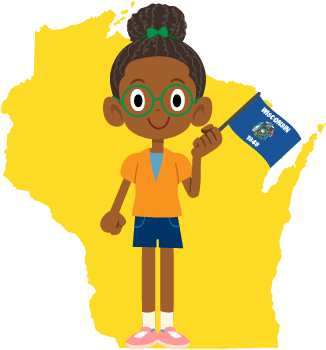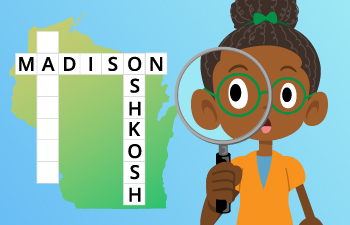Located in the north-central portion of the country, Wisconsin is one of 13 states that makes up the Midwestern U.S. As one of the leading producers of dairy in the U.S., particularly cheese, it’s no wonder Wisconsin is known as “America’s Dairyland”, or that residents are sometimes referred to as cheeseheads.
This is part of Time4Learning’s series of United States unit study supplements, where your homeschooler can learn about each state with tons of information including historical and geographical facts, educational activities, field trip ideas, and more. Learning about the Badger State is fun with our dedicated unit study supplement all about Wisconsin. Through fun facts like these, your student will be able to become more familiar with the state. You can also download our list of PreK-12 interactive activities that align with your study of interesting facts about Wisconsin.
Wisconsin Fast Facts
| Became a State |
May 29, 1848 |
|---|---|
| Order it Joined the Union |
30th state |
| State Capital |
Madison |
| State Abbreviation |
WI |
| Border States |
|
| State Flag |  |
| State Song | |
| State Flower |
Wood Violet |
| State Nicknames |
|
| Notable Wisconsinites |
|
Historical Facts About Wisconsin
Just like most states in America, Wisconsin was first inhabited years ago by Native American tribes. The Chippewa, Menominee, Oneida, Potawatomi, and Winnebago tribes were all inhabiting Wisconsin until the arrival of European settlers. The first settler was a Frenchman by the name Jean Nicolet, who arrived in 1634.
At the time of Jean Nicolet’s exploration of Wisconsin, he found lots of beaver furs. This led to interest in Wisconsin as a location for fur trading, and more Europeans began to go to Wisconsin. The land was eventually claimed for France by Jean Nicolet in 1689. However, the British began to visit Wisconsin, causing conflict between the French and English.
In 1754, during the French and Indian war, France and Britain began fighting over ownership of the land. Britain won and claimed Wisconsin as their own in 1763. Approximately 20 years later, after General George Washington won the Revolutionary war, Wisconsin became part of the lands owned by the U.S. However, this land remained undeveloped until many years later.
In the 1820s, explorers found lead ore in the land that would become Wisconsin, and settlers moved in. At this time, there were still Native Americans living on that land, which led to the Black Hawk war in an attempt to remove the Native Americans from the land. The explorers were successful and claimed the land in 1832.
Just 4 years later, the Wisconsin Territory was created by the U.S. Congress and began to grow, run mostly by farmers. Wisconsin officially was added to the Union in 1848, during James K. Polk’s presidency Wisconsin was truly developed and became industrialized during the Civil War, and remained a member of the Union.
Boost your child’s online learning experience with the Wisconsin history timeline below:
10,000 B.C.
Burial mounds were built by Native Americans to mourn the dead. The mounds are still visible today.
1630
Native Americans lived in domed shelters called “Wigwams,” made of wooden poles, bark, and grass
1634
Jean Nicolet was the first explorer to set foot in Wisconsin. He was looking for a Northwest Passage to China
1689
Wisconsin becomes known as a trading post for furs, and the land was claimed by Jean Nicolet for France
1754
British and French began to fight over ownership of Wisconsin, during the French and Indian War. Native Americans fought on both sides, some supporting the British while other supported the French.
1763
The British won ownership over Wisconsin
1788
The United States owned Wisconsin and the rest of the Northwest Territory, after the Revolutionary War. The English still partially inhabited the land.
1812
Americans finally defeated the Europeans and kicked them out of the Northwest Territory once and for all.
1820
Lead ore became popular and helped to increase development and economy. The settlers removed the Native Americans while looking for more ore. The state received the nickname “the Badger State” because the way miners made holes and slept in them while looking for lead is just like how badgers burrow.
1832
The Black Hawk War occurred because the Fox and Sauk tribes tried to move back to Wisconsin. It got its name because the tribes at war were under the command of Chief Black Hawk. They were defeated in the Battle of Bad Axe. During the Black Hawk War, Abraham Lincoln was a member of the U.S. Army fighting against the tribes.
1836
Wisconsin territory was created by the U.S. Congress
1841
Developed the first cheese-making factory in 1841. They love their cheese so much that there’s even a cheese museum that creates a 90lb wheel of cheese every year.
1848
Wisconsin was admitted to the Union
1865
The Civil War did not have any major battles in Wisconsin, but the state did send over 90,000 soldiers to fight for the Union. Wisconsin became industrialized and developed at this time.
1919
The Green Bay Packers football team is established
Bring history and geography to life with Time4Learning’s interactive online social studies curriculum for grades 2-12.
Geographical Facts About Wisconsin
Can your homeschooler locate Wisconsin on this printable U.S. map? Wisconsin got its name because of the large river that runs through the state – it means red stone river. This great river eventually connects with the famous Mississippi River, and this connection was used during European exploration. These are just some of the interesting facts about the Badger State’s geography that your homeschooler will find interesting.
To enhance your unit study supplement, explore a map of the state, then download our printable Wisconsin map below and mark it up with your child. Here are some facts you and your homeschooler may want to note about Wisconsin’s geography and unique features.
- The highest point is Timms Hill, which is 1,951 ft; Lake Michigan is the lowest point.
- Wisconsin is made up of 72 counties.
- The largest city is Milwaukee, with a population of approximately 595,000. It is in the southeast portion of the state, located on Lake Michigan.
- Madison is located in the southern part of Wisconsin, about 50 miles from the Wisconsin-Illinois border. Belmont, the original capital, is about 50 miles southwest of Madison, and Milwaukee is 80 miles directly east.
- Wisconsin is known for its farmland because of the rich soil left by the glaciers that cut the tops off of hills. There are also over 15,000 lakes because of the ice age!
- Wisconsin is actually the Swiss Cheese Capital of the World.
- Sheboygan, which is 100 miles northeast of Madison, is the Bratwurst Capital of the World. There is also the World’s Largest Brat Fest, which takes place in Madison every Memorial Day weekend.
- The oldest city in Wisconsin is Green Bay, which is 140 miles northeast of Madison. It was established when Jean Nicolet started a fur trading post in 1634.
- Lake Michigan borders Wisconsin to the east.
- The Central Plain is a U-shaped, which borders with states Michigan and Minnesota.
Wisconsin State Map
Download our FREE Wisconsin state map printable. Use it as a coloring page or use it to plot the state’s geographical features.
Activities for Children in Wisconsin
Whether you homeschool in the state of Wisconsin or are just visiting, below is a list of field trip ideas that will help supplement the Wisconsin facts unit study. You’ll find everything from art and science museums to outdoor activities in national parks.
- Milwaukee Art Museum (Milwaukee) – With a collection of over 25,000 works of art, this museum is one of the largest in the country. Established in 1882, the art museum offers various educational programs, youth studio classes, and summer camps. Admission for Kids 12 & under is free.
- Apostle Islands National Lakeshore (Bayfield) – Located on the northern tip of the state on Lake Superior, this recreational park features 21 islands, lighthouses and caves to explore. Visitors can hike, camp, kayak. Guided activities include lighthouse tours, campfire programs, and more.
- Discovery World (Milwaukee) – This science and technology center museum features over a dozen interactive exhibits that include the Reiman Aquarium, Simple Machine Shipyard, Clean Air Trek, and more. The museum also offers interactive tours, lab experiences, and homeschool days.
- Ice Age National Scenic Trail (Eagle) – Stretching 1,200 miles across the state and tracing a huge glacier that once covered much of North America, this park offer endless indoor and outdoor activities. The park’s western end is located in Polk County and on the eastern end in Door County. Families can hike, birdwatch, camp, stargaze, visit the interpretive centers, and more.
Wisconsin Freebies and Deals for Homeschoolers
- Aquanut Water Shows (Twin Lakes) – Take in some impressive stunts by water skiers at these free shows that take place every Wednesday and Sunday at Lance Park.
- Jelly Belly Factory Tour (Pleasant Prairie) – Who doesn’t want to take a free ride on the Jelly Belly express train? Take a free warehouse tour (offered daily) and learn how these sweet treats are made. Be sure to stop at the interactive Jelly Belly Station for fun games, samples, and more.
- Wisconsin Veterans Museum (Madison) – Established in 1901, this museum and research center is dedicated to the veterans and soldiers of Wisconsin. The museum features rotating exhibits, as well as various programs and events for students of all ages.
- Iron River National Fish Hatchery (Iron River) – Established in 1979, families can learn more about fish conservation at this hatchery that also features an informative visitor center and several aquariums. The hatchery’s 1,200 acres also provides a trail system for visitors to explore.
Wisconsin Learning Games for Children
Learn even more about the Badger State and test your child’s knowledge about Wisconsin facts with these free learning resources.












